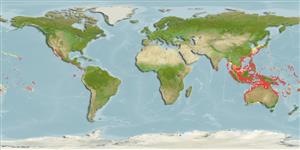>
Eupercaria/misc (Various families in series Eupercaria) >
Labridae (Wrasses) > Corinae
Etymology: Halichoeres: Greek, als, alis = salt + Greek, choiros = pig (Ref. 45335).
Eponymy: Dr Joseph Hartzfeld (1815–1885) was a German physician who was a Principal Medical Officer of the Royal Dutch East Indies Army (1841–1869). [...] (Ref. 128868), visit book page.
More on author: Bleeker.
Environment: milieu / climate zone / distribuzione batimetrica / distribution range
Ecologia
marino associati a barriera corallina; distribuzione batimetrica 10 - 70 m (Ref. 12472). Tropical
Western Pacific: tropical, north to southern Japan; may ultimately be regarded as a subspecies of Halichoeres zeylonsis of the Indian Ocean. Also recorded from Indonesia, Mentawai Island (Ref. 5978).
Size / Peso / Age
Maturità: Lm ? range ? - ? cm
Max length : 18.0 cm TL maschio/sesso non determinato; (Ref. 9002); peso massimo pubblicato: 82.64 g (Ref. 124708)
Short description
Chiavi di identificazione | Morfologia | Morfometria
Spine dorsali (totale) : 9; Raggi dorsali molli (totale) : 11; Spine anali: 3; Raggi anali molli: 11. Juveniles are off-white with a broad yellow lateral band.
Body shape (shape guide): fusiform / normal.
Inhabits seaward reefs, prefers open expanses of sand or mixed sand, rubble, and pavement usually below 11 m. Occurs in loose groups of one male and numerous smaller females and juveniles. Small groups of females and males moving over large areas by themselves, regularly checking females (Ref. 48636).
Life cycle and mating behavior
Maturità | Riproduzione | Deposizione | Uova | Fecundity | Larve
Distinct pairing during breeding (Ref. 205).
Myers, R.F., 1991. Micronesian reef fishes. Second Ed. Coral Graphics, Barrigada, Guam. 298 p. (Ref. 1602)
IUCN Red List Status (Ref. 130435: Version 2025-1)
Threat to humans
Harmless
Human uses
Pesca: commerciale; Acquario: Commerciale
Strumenti
Special reports
Download XML
Fonti Internet
Estimates based on models
Preferred temperature (Fonte Biblio.
123201): 24.3 - 28.9, mean 27.7 °C (based on 514 cells).
Phylogenetic diversity index (Fonte Biblio.
82804): PD
50 = 0.5000 [Uniqueness, from 0.5 = low to 2.0 = high].
Bayesian length-weight: a=0.00977 (0.00468 - 0.02039), b=3.09 (2.92 - 3.26), in cm total length, based on LWR estimates for this Genus-body shape (Ref.
93245).
Trophic level (Fonte Biblio.
69278): 3.5 ±0.5 se; based on size and trophs of closest relatives
Resilienza (Fonte Biblio.
120179): Alto, tempo minimo di raddoppiamento della popolazione meno di 15 mesi (Preliminary K or Fecundity.).
Fishing Vulnerability (Ref.
59153): Low vulnerability (10 of 100).
🛈
Nutrients (Ref.
124155): Calcium = 73.2 [44.4, 120.5] mg/100g; Iron = 0.681 [0.404, 1.233] mg/100g; Protein = 18.4 [15.6, 20.6] %; Omega3 = 0.165 [0.108, 0.252] g/100g; Selenium = 28.8 [17.7, 49.2] μg/100g; VitaminA = 132 [41, 493] μg/100g; Zinc = 1.59 [1.11, 2.49] mg/100g (wet weight);
